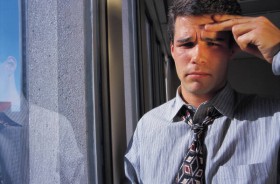The issue surfaces as something like …
“I invite clients to have lunch and I don’t hear back from them.” “I guess this means they really aren’t interested in getting together.”
Do you really think that’s true? Do your clients and prospects not want to talk to you? You do offer value added services that improve revenues or cut costs don’t you? Or do the services reduce risks, improve client satisfaction or improve productivity? Maybe they just make the client compliant in some way? Why would they not want to see you? Wouldn’t you see someone who could do that for you?
Now ask yourself this question. Do you have unanswered e-mails in your inbox? Email overload is a problem for most business people.
I know I do! People are very very busy. Their inboxes are full of e-mails that range from urgent/important to annoying /unimportant. Given that reality, returning your e-mail may just not be as high a priority for them as getting a response to that e-mail is to you. A different slant on your email etiquette can help.
Fortunately, there are a few things you can do to get more responses to your invitations.
1. Ask again. One or two non-responses do not make a rejection.
2. Make a call instead of e-mailing (and leave a really good voice mail if you don’t speak to them ).
3. Try at a different time of day. Their schedule may be less frantic on Friday afternoon than on Monday morning. After hours may be a better time than the middle of the day. Early better for them than late.
4. Make your invitation VERY specific. Please don’t write something like “Let’s have lunch soon,”. Much better to ask “Are you available for lunch on Monday, April 22 or Wednesday April 24.” Alternatively, give them a window of time for a phone call — the morning of the 19th or the afternoon of the 25th . If they’re not available on the dates you suggest, ask them specifically to counter with dates or times they are available.
5. Consider inviting them to something other than lunch. Lots of people tend to eat lunch at their desk. Suggest breakfast. How about dropping by their office for 15 minutes and bringing along their favorite Starbucks order? Maybe an early evening phone or Skype meeting? Connecting at a conference you both plan to attend?
Rob Biggin is the founder of Rainmaker Coaching, leaders in business coaching and mentoring to improve business performance. This was originally posted on his blog and we thank Rob for sharing it with us.
Tags: corporate email etiquette, email, email best practice, Rainmaker coaching, Rob Biggin
Chairing a large committee made me think about how we use email to work more effectively whilst at the same time fostering transparency and enthusiasm.
Everyone feels that as Chairman I should be cc’d into all conversations. Does that sound familiar? Despite a good folder and flag system at one point the email overload was so acute that important emails were overlooked. Even as the email expert I found myself phoning the already busy secretariat to re-send me papers and attendance lists which were lost in the cc swamp. This prompted me to think what would be the best email etiquette for both Chairman and committee members? Here are the seven email best practice guidelines we are working on to reduce the email overload and save everyone time.
1. Avoid ‘Reply All’ unless it is critical. For everyday responses to simple requests, eg do you need parking, gluten free sandwiches – forget Reply All. Reply to sender only will suffice.
2. Use Distribution lists. When a Distribution list is not possible put people’s names on the Bcc box. If you want to know what your colleagues think, ask them directly but don’t copy in the Chairman.

Email etiquette for committee meetings
3. If you have something controversial and decide to write an email, put it in draft and sleep on it before hitting send. If you still feel strongly talk to those concerned before sending the email. This avoids lighting fires which are hard to contain. After talking if there is still an unresolved issue then write a summary email.
4. Use a clear subject line to highlight what your email is about. Sounds obvious, but you would be amazed how many emails linger in my Committee folder with the same subject but referring to quite a different topics!
5. Decide from whom you really need a reply and then use the ‘To’ and ‘Cc’ address line as they were intended. ‘To’ is for action from those whose name is in that line. ‘Cc’ is for information: if your name is in that line no reply is necessary. Good email etiquette dictates that if you are in the cc line and feel you must voice your opinion, only reply to the sender .
6. For sending committee papers use a file sharing service like Dropbox for sending attachments.
7. Meeting dates – send them and the reminder as a calendar invite. This saves time collating responses and ensures the meeting automatically goes into member’s calendar.
Hopefully these short term measures of good email etiquette will reduce the email overload. Longer term we plan to introduce social technologies to reduce the email overload and improve performance even further.
If you either chair or support committees and found these tips helpful why not ask us about our Brilliant Email master classes. These are guaranteed help every committee member save time and improve communications. Making life simpler and more enjoyable for your committee will earn you considerable brownie points.
Meanwhile, how do you use email to communicate and share information efficiently across committees?
Tags: committees, corporate email etiquette, email etiquette
Saying ‘thank you’ is about both the medium and the content as David Tang wrote in the Financial Times last week. A point I whole heartily endorse. It is about conveying sincerity and it is better to send an email than do nothing. If you choose to use email what is the best email etiquette to demonstrate sincerity?
Here are some tips.

BomoArt Note Card
informative. The day spent at was ……
Call me old fashioned, (but as discussed previously) for my part I still prefer to send a conventional hand written note to express my gratitude, when someone has gone the extra mile. And of course I am lucky having BomoArt as my sponsor who provide me with the exquisite cards to do so. That said, there is something about taking the time to buy a card that adds depth to the thank you.
However, in this day and age when first, many people are time poor and second, many cannot write properly and rely wholly on electronic devices, hopefully good email etiquette will help convey sincerity.
These are some of the aspects covered in Mesmo Consultancy’s Brilliant Email etiquette training masterclasses.
Tags: corporate email etiquette, email etiquette, email etiquette training, thank you emails
We all like to feel valued when we have either helped someone or done something really well. Many feel that saying thank you encourages better team work and bonding. A point supported by David Desento’s research. But what is the best way to say thank you? A thank you email is one way and is often the default. However, how many of those ‘thank you’ emails are really sent with genuine warmth and gratitude? For those who receive over 50 emails a day, the ‘thank you’ either might be overlooked or worse still just add to feeling of suffering with chronic email and information overload.
In workshops and coaching sessions, when asked what annoys people the most about email, 75% cite ‘thank you’ emails. Many perceive they are sent without thinking but rather almost as a Pavlovian response which is meaningless and without any feeling of real gratitude. After all if the boss ask for something why would you not do it.
In this age of electronic communications what is the best email etiquette to say thank you and do with feeling? Drawing on discussions with clients and their experience here are some which work really well without driving up the email overload.
1. Add a line at the end of the original email to show your gratitude in advance of the response.
2. If the person has gone the extra mile and done an exceptional job then:
either

BomoArt Note Card
especially if the person has gone the extra mile).
or
3. Only if none of the above work, should you ping back a ‘thanks’ email. But make sure it sounds sincere and it stops there. Don’t be sucked in to a pointless round of email ping-pong if they respond.
Using good email etiquette like this and switching to an alternative medium is also a very good way to improve performance and business relationships whilst at the same time reducing email and information overload.
For more ways like these to save time and enhance productivity ask us about our email best practice training and coaching.
Tags: corporate email etiquette, email best practice, email overload, thank you emails

Email bullying?
In the USA, October is national prevent bullying month. We do not appear to have anything similar in the UK which is a shame especially as there have been a few cases of young people committing suicide through feeling bullied on Facebook etc.
Email too can easily be used to bully people. For example leaving insufficient time to reply, constantly sending email reminders and demands. Sending rude, arrogant and abrasive emails can be stressful too for the recipient. Attaching read receipt and reminder flags might also be deemed bully tactics. Such harassment is a drain on productivity as found previously. Perhaps the most serious form of email bullying is expecting people to reply too quickly and often outside acceptable working hours. Moreover, email bullying adds to the email overload and hence stress levels.
Any form of bullying is to be deplored and is unacceptable. Social technologies and email have just made it easier to do in a hidden and often covert manner. Deleting and/or ignoring such emails is not an option.
VW recently stopped sending email to workers Blackberrys thirty minutes after their shift ended. That is taking a sledge hammer to crack a nut.
At Mesmo Consultancy we have found a more informed a sustainable solution is to implement a proper email management code of conduct and email best practice charter. It should contain both what is acceptable email behaviour and the procedure if you are on the receiving end of email bullying.
Have you ever been bullied by email? Does your organisation have such an email management code of conduct?
Tags: corporate email etiquette, email best practice, email bullying, email management, email response times, email stress, Mesmo Consultancy